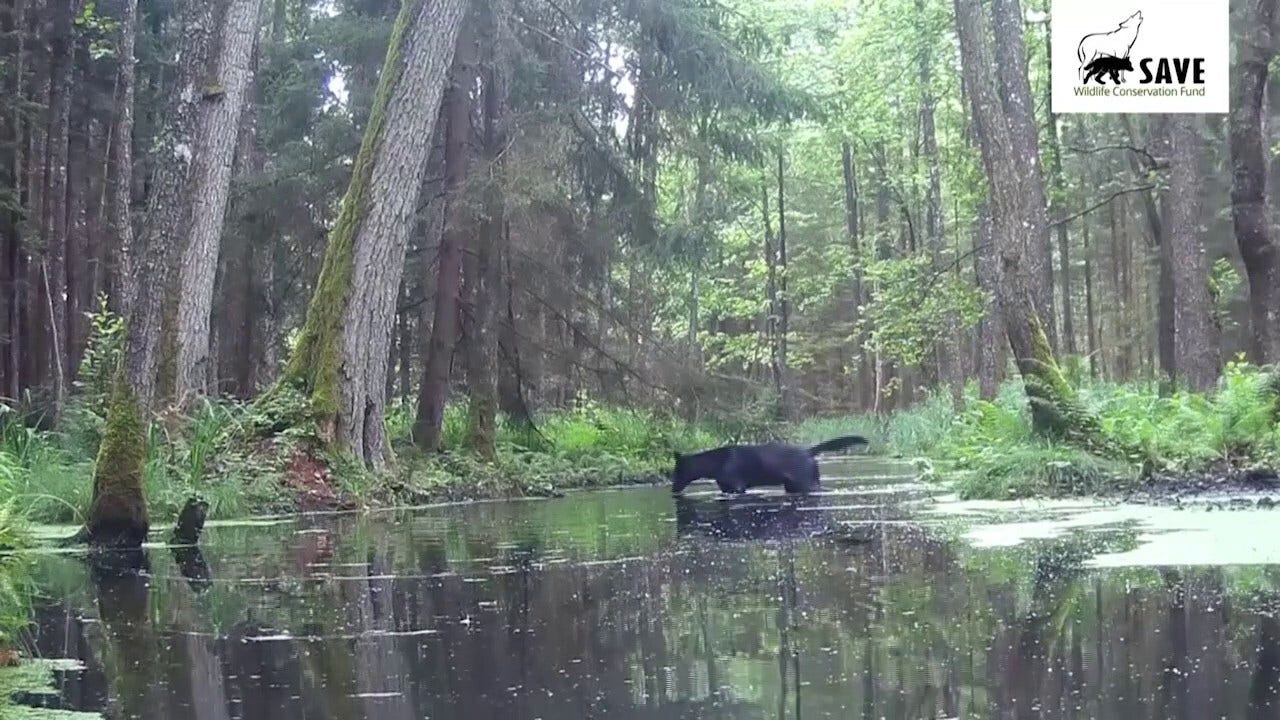World
Rare wildlife spotting caught on camera in Poland

Rare Sighting of Black Wolves Captured in Poland
In a rare and remarkable sighting, two unusual black wolves, believed to be siblings, were caught on camera crossing a stream in a forest in Poland. The footage, captured last year, has sparked interest among scientists and conservationists, who are now working to learn more about the genetics of these rare animals. The SAVE Wildlife Conservation Fund Poland retrieved scat droppings from the forest to aid in their research. This unusual encounter has not only shed light on the presence of black wolves in the region but also highlights the importance of conservation efforts in protecting these majestic creatures.
A Surprising Discovery in the Forest
The video footage was captured by Joanna Toczydlowska, a project coordinator with the SAVE Wildlife Conservation Fund Poland, who had set up a camera trap to study beavers. Imagine her surprise when she reviewed the footage and found wolves instead! The unexpected appearance of these rare black wolves led her to leave the camera in place, hoping to gather more information about their behavior and habitat. The footage revealed a gray wolf and a black wolf crossing a stream, their movements slow and deliberate as the water reached almost up to their bellies. Once they reached the other side, they jumped onto the bank and disappeared into the forest.
In another clip recorded during the fall, two black wolves and a gray wolf were seen crossing the same stream. These sightings have provided rare insights into the lives of these elusive animals. However, the exact location of the sightings has not been disclosed to protect the wolves from potential harm. The discovery of these black wolves is particularly significant, as they are far less common than their gray counterparts in Poland.
The Genetic Mystery of Black Wolves
The majority of Poland’s nearly 3,000 wolves are gray with red or black accents, making the sighting of all-black wolves a rare phenomenon. Scientists believe that the black coloration is likely the result of a genetic mutation that occurred thousands of years ago, possibly linked to interactions with domesticated dogs. While dark fur is rare in Europe, it is more common in other parts of the world, such as Yellowstone National Park in the United States, where at least half of the wolf population has black fur.
The two black wolves captured on camera are believed to be siblings, around a year old, and weighed approximately 66 pounds. At least one of the black wolves was identified as male. Wolves typically travel in family groups, and the presence of these two black wolves suggests that they may be part of a larger pack. This discovery has opened up new avenues for research into the genetic diversity of wolves in Poland and beyond.
Conservation Efforts and Public Education
Wolves were nearly extinct in Poland by the 1950s, but their population has rebounded in recent years, particularly in the central part of the country. However, their presence still poses challenges for humans living in or near wolf-inhabited areas. Organizations like the SAVE Wildlife Conservation Fund Poland are working tirelessly to educate the public on how to coexist safely with these wild animals.
Roman Gula, the head of the organization’s wolf monitoring project, emphasized the importance of education in helping people understand and appreciate wolves. “For people, it’s a new phenomenon,” he said, highlighting the need for programs that promote peaceful coexistence between humans and wolves. By educating the public and conducting scientific research, conservationists hope to ensure the survival of these magnificent creatures for generations to come.
A Glimpse into the Future of Wolf Conservation
The rare sighting of black wolves in Poland serves as a reminder of the beauty and diversity of nature. It also underscores the importance of conservation efforts in protecting vulnerable species. As scientists continue to study the genetics and behavior of these wolves, they hope to gain a deeper understanding of their role in the ecosystem. Meanwhile, the work of organizations like the SAVE Wildlife Conservation Fund Poland is essential in safeguarding these animals and their habitats.
The discovery of these black wolves is not just a scientific breakthrough but also a testament to the resilience of nature. As we move forward, it is crucial to strike a balance between human activities and wildlife conservation, ensuring that wolves like these can continue to thrive in their natural habitats. The story of these rare black wolves is a powerful reminder of the wonders that await us when we invest in protecting the natural world.











